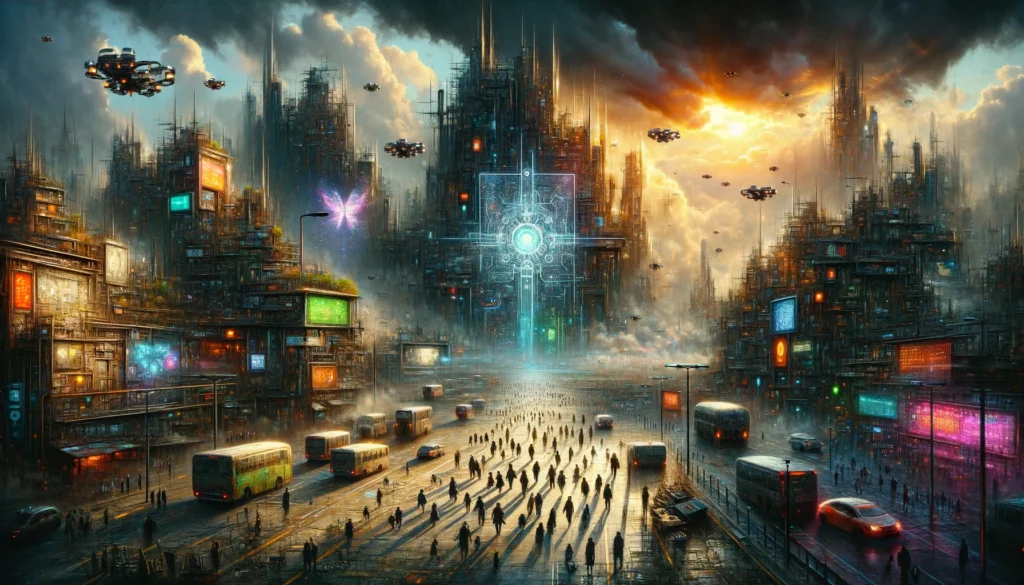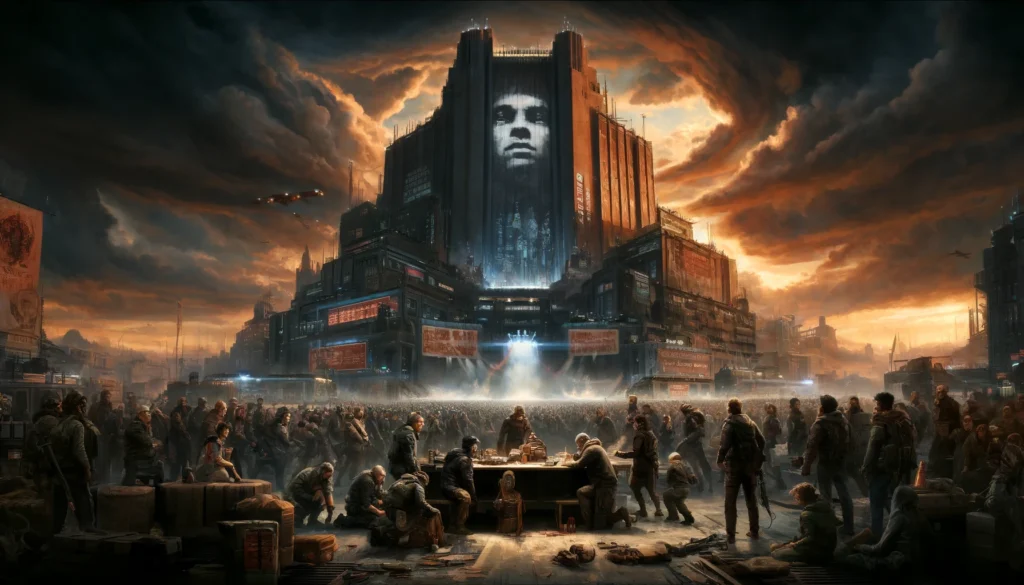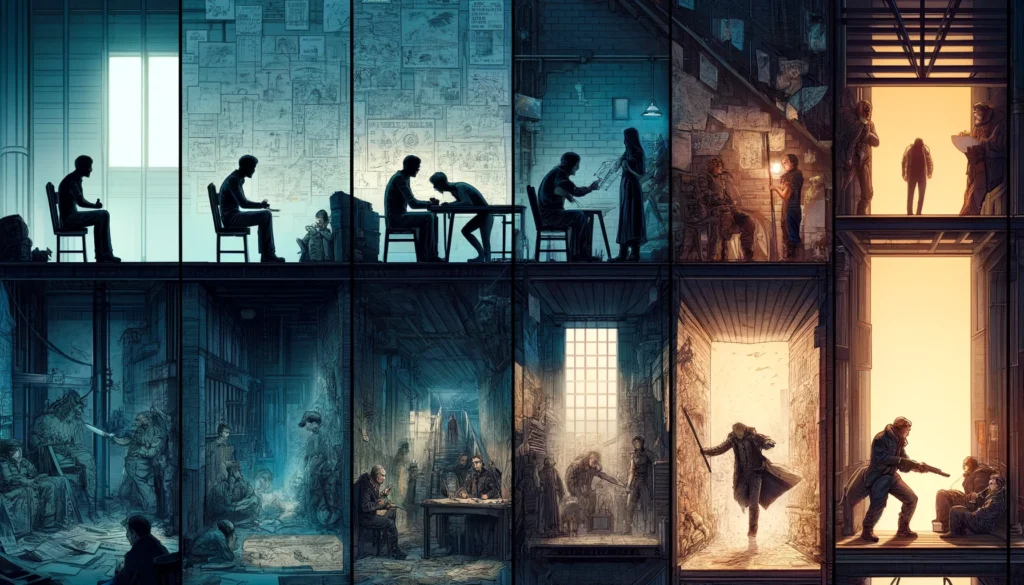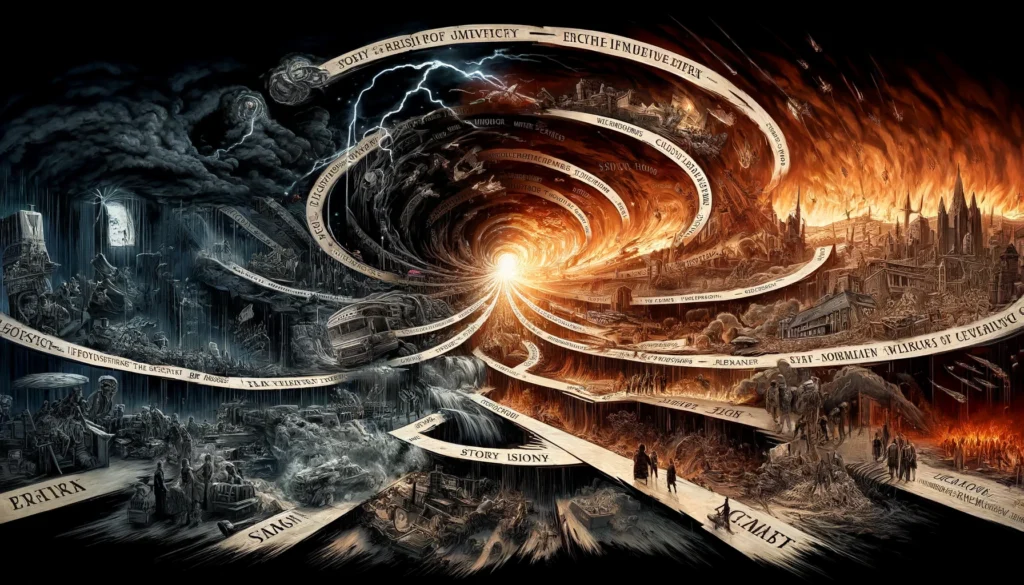Have you ever imagined a world where society doesn’t work quite right, where the rules are too strict, or where freedom is just a distant memory? That’s what dystopian stories are all about!
They take us to futures or alternate realities where things have gone sideways in some big way. Writing a dystopian story isn’t just about creating a gloomy world, though. It’s a chance to explore big ideas and ask “what if?” questions that make us think about our own world in a new way. If you want to learn how to write a dystopian story that keeps reader intrigued, keep on reading.
Dystopian Fiction Defined: Exploring Dark Futures

Understanding Dystopian Fiction: A Deep Dive
Dystopian fiction is a genre of stories that explore social and political structures in a dark, nightmare world. It’s like taking our world, adding some big changes that don’t turn out well, and seeing what happens.
These stories often show us a society that’s trying to create a perfect world (a utopia), but ends up creating the opposite (a dystopia). Why do people love these kinds of stories? Because they’re exciting, they make us think, and they show us the importance of fighting for what’s right.
The Captivating Appeal of Dystopian Narratives
There’s something strangely captivating about reading or watching stories set in dystopian worlds. Maybe it’s because they’re so different from our daily lives, or perhaps it’s the thrill of seeing heroes stand up to powerful forces.
These stories grab our attention by showing us extreme versions of problems we see in the world today. They can warn us about where we might end up if we’re not careful, or inspire us to change our ways before it’s too late. Plus, who doesn’t love a good adventure in a world unlike any we’ve known?
By diving into the depths of dystopian fiction, writers have the unique opportunity to mirror the anxieties of our times, challenge societal norms, and explore the resilience of the human spirit. Whether through the oppressive regimes of George Orwell’s “1984” or the survivalist grit of Suzanne Collins’ “The Hunger Games,” dystopian tales continue to fascinate and provoke thought among readers of all ages.
Crafting Your Dystopian Story: A Step-by-Step Guide
1. Choosing the Core Conflict of Your Dystopian Novel

Start by asking yourself, “What big problem does my world face?” This could be anything from environmental disaster to a totalitarian government. Think about what scares you or what you’re passionate about fixing in our world today. This fear or passion is a great place to start building your dystopian society.
2. Worldbuilding in Dystopian Fiction: Creating Unique Dystopias
Creating a compelling dystopian world is central to your novel’s success. This step is where your creativity truly comes into play, where the rules of reality can be bent, and new norms are established.
Setting the Scene
When you write a dystopian story, the setting lays the foundation for the events that unfold. It’s not just a backdrop but an active participant in the narrative. Will your story be set in the ruins of a post-apocalyptic Earth in 2024, or will it explore life on earth in a completely different realm?
The choice of setting directly influences the tone of your dystopian novel and should resonate with the themes you wish to explore.
Designing the Society
The society in your dystopian fiction will reflect the core conflicts driving your narrative. It could be a society where ‘Big Brother’ is always watching, reminiscent of Orwell’s dystopian classic, or one where communication is limited to prevent dissent.
Constructing the rules and structure of your society is a fundamental piece of worldbuilding. Here, you can draw from a lot of dystopian novels and fiction subgenres for inspiration. The more detailed and thought-out your society’s rules are, the more immersive your story will be.
Technology and Environment
In many great dystopian stories, technology and environment are used as mechanisms of control or survival. Consider a world similar to Bradbury’s ‘Fahrenheit 451’, where books are banned and ‘firemen’ burn any found.
Your fictional dystopia could feature advanced technologies that manipulate climate, surveil citizens, or enforce conformity. Weaving in these details is crucial for writing dystopian fiction that feels complete and believable.
Languages and Communication
Language evolves as societies do, and in a dystopian setting, it can be a powerful signifier of change. In your writing process, think about how communication has transformed in your world. Have new dialects emerged? Are certain words now taboo? The development or regression of language in your dystopian book can be a subtle indicator of societal shifts and is an integral part of worldbuilding.
By focusing on these aspects, you create a version of a dystopian society that is unique to your story. The worldbuilding process is a balancing act—your setting should be extraordinary enough to fascinate but relatable enough to reflect the foibles of human society.
Keep in mind that the world you’re creating should be more than just a backdrop for the characters—it should challenge them, shape their identities, and compel the plot forward. Whether your story is set in a dystopian future or a fictional dystopia, it’s the intricacies of the world that will keep your readers engaged and the pages turning.
3. Developing Characters in a Dystopian Setting

As you brainstorm the cast of your fictional world, you’ll want to include archetypes that resonate with the central conflict of the dystopian genre. In a story set in a dystopian future, characters like the Reluctant Hero often reflect society’s biggest issue and become key players in the narrative. They can start as a mere ‘citizen’ but evolve, pushing the story forward by challenging the oppressive society and possibly an all-powerful totalitarian government.
Crafting Believable Protagonists
When you write one, keep in mind that a good dystopian fiction story hinges on a protagonist with a believable backstory. This character is not just surviving in a dystopian society but is often pitted against it, revealing humanity’s resilience. Whether their dissent against the ruling regime is sparked by personal loss or societal pressures, their struggle is what keeps readers turning the pages.
Conflict and Growth
Great dystopian stories pivot on conflict, both external and internal. Your characters should grapple with the cultural norms and censorship that riddle their society, feeling trapped but seeking ways to express individualism. Each conflict in your story doesn’t just add tension, it’s a stepping stone for character growth and a reflection of the broader dystopian writing themes.
The Importance of Flaws
As you outline your characters, infuse them with flaws that readers can empathize with. Remember, in many dystopian novels, it’s the characters’ imperfections that make them feel real and add depth to the narrative. Whether they’re dealing with the secret police or trying to survive in a barbarous future world, their flaws should challenge their goals and spur personal growth.
Dynamics and Relationships
Dynamics within a dystopian society often teeter on the brink of being utopian ideals twisted into something more sinister. Friendships and family relationships become complex when set against a backdrop of social norms and dissent. Want to write a dystopian tale that explores the breadth of human emotions? Then ensure your characters embody the full spectrum of relationships influenced by their oppressive world.
Language and Dialogue
Dystopian writing thrives on the subtleties of language. In your fictional dystopian society, how characters communicate can either uphold the status quo or act as a vehicle for rebellion. As you craft dialogue, ponder on how the words your characters use, or are forbidden to use, reflect the state of the world they live in and their place within it.
Moral Dilemmas
Incorporating moral dilemmas is a masterclass in writing dystopian fiction. These challenging situations compel your characters—and by extension, your readers—to question the ethics of the society you’ve created. Whether it’s a secret uprising against an oppressive regime or a choice that could change the course of your story, these dilemmas are pivotal to the depth of your narrative.
Focusing on these facets of character development can turn tips for writing dystopian fiction into a blueprint for creating a tapestry of characters that embody the complex world of your story. They are the ones who will experience the censorship, the climate crises, and the pandemics you imagine.
They will navigate the totalitarian regimes and the societal collapses that typify the dystopian future you are set to explore. Your characters don’t just inhabit a world set in a dystopian future—they bring it to life, offering multiple points of view and experiences that challenge the reader to think and feel alongside them.
4. Plotting a Dystopian Story: From Inciting Incidents to Climax

Crafting the plot of your dystopian novel is a pivotal stage where your creativity meets structure. This phase is where you’ll apply what you’ve learned about how to write a dystopian story, turning your vision into a coherent narrative that captivates readers from start to finish.
The Inciting Incident
Every memorable dystopian fiction starts with a spark—an inciting incident that propels your protagonist from their normal, albeit dystopian, life into the heart of the conflict. It might be a forbidden glimpse of truth in a society shrouded by the ‘Big Brother’-like surveillance, akin to the scenarios depicted in Orwell’s and Bradbury’s speculative fiction.
Or perhaps it’s an unexpected encounter that challenges their role as a citizen in a tightly controlled world. This moment is crucial; it’s what hooks your readers and gets the ball rolling towards the unfolding drama.
Major Conflicts
As your protagonist navigates through the dystopian world you’ve created, they’ll face a series of obstacles that test their mettle. These challenges could range from external conflicts, such as skirmishes with the oppressive government or the struggle to survive in a world ravaged by climate extremes, to internal conflicts, where they grapple with their beliefs and motivations.
Drawing from the dystopian literature subgenre, think about what makes stories like ‘Fahrenheit 451’ or Palahniuk’s narratives compelling—how the characters’ battles, both external and internal, push them towards growth. Your aim should be to weave conflicts that not only drive the narrative forward but also deepen the reader’s investment in your protagonist’s journey.
Climax and Resolution
The climax of your dystopian novel is the moment where the tensions reach their zenith. It’s the culmination of your protagonist’s struggles, where the stakes are at their highest. Whether it’s a showdown with the totalitarian regime, a final attempt to escape an all-encompassing dystopic society, or a personal revelation that changes everything, this is the point where the narrative threads come together.
Following the climax, the resolution should offer a sense of closure, whether it’s through a triumphant victory, a bittersweet compromise, or even a tragic loss. Keep in mind that while the ending may not always be happy, it should feel earned and meaningful, leaving your readers reflecting on the journey and the themes explored within your story.
5. Themes and Messages: Reflecting on Society Through Dystopia
Think about what you want your readers to take away from your story. Dystopian fiction often deals with themes like freedom, resistance, and the human spirit. Let these themes guide your storytelling.
Advanced Writing Tips for Crafting Dystopian Fiction
- Show, Don’t Tell: Instead of explaining your world’s rules, show them through your characters’ actions and experiences.
- Maintaining Believability: Even though you’re creating a new world, it has to feel real. Your characters’ reactions and the societal structures should make sense.
- Innovative Thinking: Dystopian fiction has been done many times, so look for unique angles or untold stories.
Remember, writing a dystopian story is about more than just setting a tale in a bleak future. It’s an opportunity to explore deep questions about society, humanity, and what we value most. By following these steps, you’ll be well on your way to crafting a story that not only entertains but also makes your readers think.
Polishing and Refining Your Dystopian Story
After dedicating much effort to drafting your dystopian narrative, refining your manuscript is critical to ensure it fully resonates with your audience and your message is conveyed with clarity. This stage involves meticulous review and enhancement of your work.
Editing and Revising for Clarity and Impact
First Round of Edits: Begin with a broad evaluation of your story. Identify any plot inconsistencies, fully flesh out character arcs, and ensure the pacing captivates your readers from start to finish. Recall Ray Bradbury’s wisdom that the initial draft is merely the beginning of your writing journey.
Feedback Loop: Engage with a trusted circle of friends, family, or writing group members for their insights. Just as George Orwell’s concept of ‘Big Brother’ challenges readers to think critically, feedback can reveal areas needing clarity or further development in your narrative.
Refine and Polish: Focus intently on refining your prose, enhancing language and style for maximum impact. Characterization is pivotal at this stage—your characters should embody authenticity, making readers fully invest in their journeys. Reflect societal issues like climate change, surveillance, or the quest for freedom through the dynamics of your story’s world.
Feedback and Critique: Enhancing Your Narrative Through External Insights
Beta Readers: Select beta readers who appreciate dystopian themes, as they can provide targeted feedback on your story’s believability, character development, and thematic depth, offering perspectives on how your narrative fits within the broader dystopian genre.
Writing Groups: Participation in writing groups can yield fresh perspectives and constructive critique, facilitating a collaborative approach to refining your work. This support network is invaluable for gaining diverse insights and encouragement throughout the revision process.
Writing a dystopian novel offers an unparalleled opportunity to delve into speculative “what if” scenarios, critique societal norms, and envisage a distinct future. Embrace the writing process as iterative, recognizing that each revision enhances the depth and appeal of your narrative.
Aim to leave your readers contemplating, feeling, and potentially viewing their reality differently after experiencing your story. Through commitment, meticulous refinement, and embracing the revision process, your dystopian tale has the potential to leave a lasting impression, inviting readers to ponder its themes long after the final page.
Wrap Up
Writing a dystopian fiction novel offers a unique canvas for writers to explore the depths of human resilience against the backdrop of a society gone awry. From the initial steps of identifying a central conflict that speaks to contemporary fears to the intricate process of world-building and character development, crafting a dystopian narrative is as challenging as it is rewarding.
Luckily there are tools at your disposal to help you with the writer’s block, ideas, and whatnot. So checkout some of the best ai software to help you write like an army of 1000 writers.
